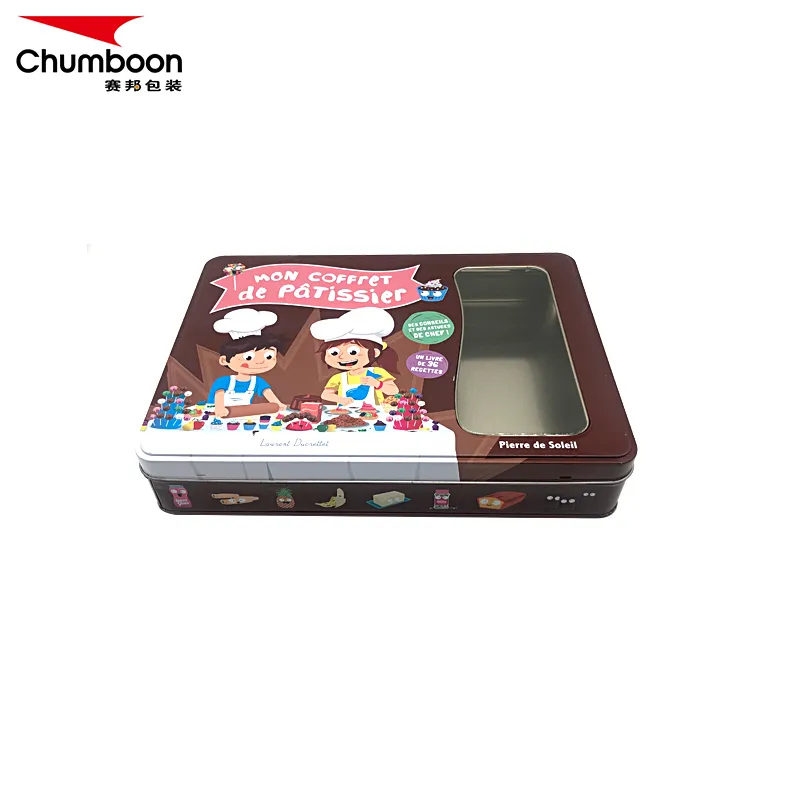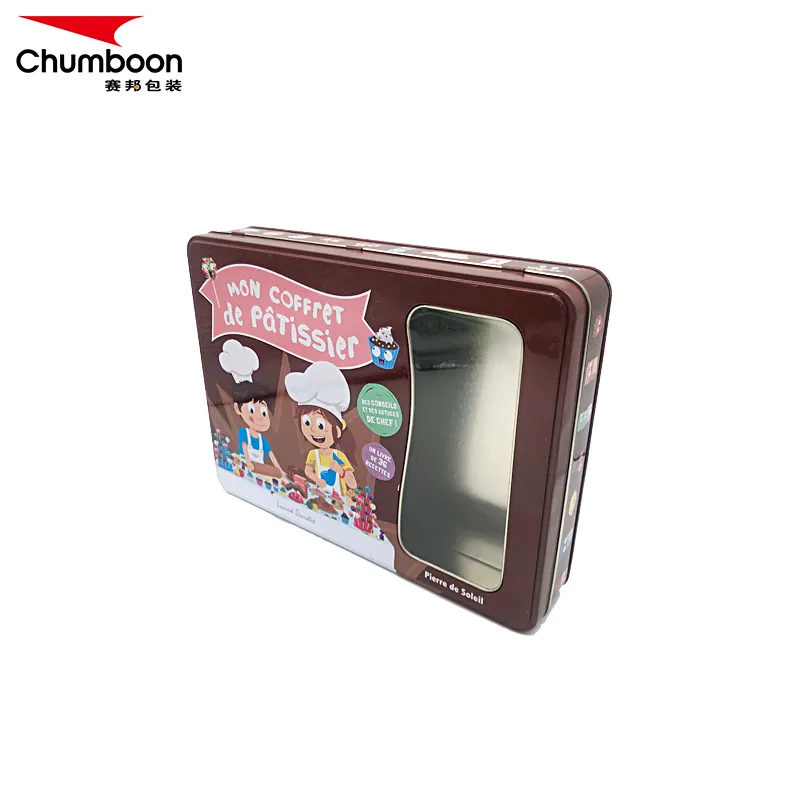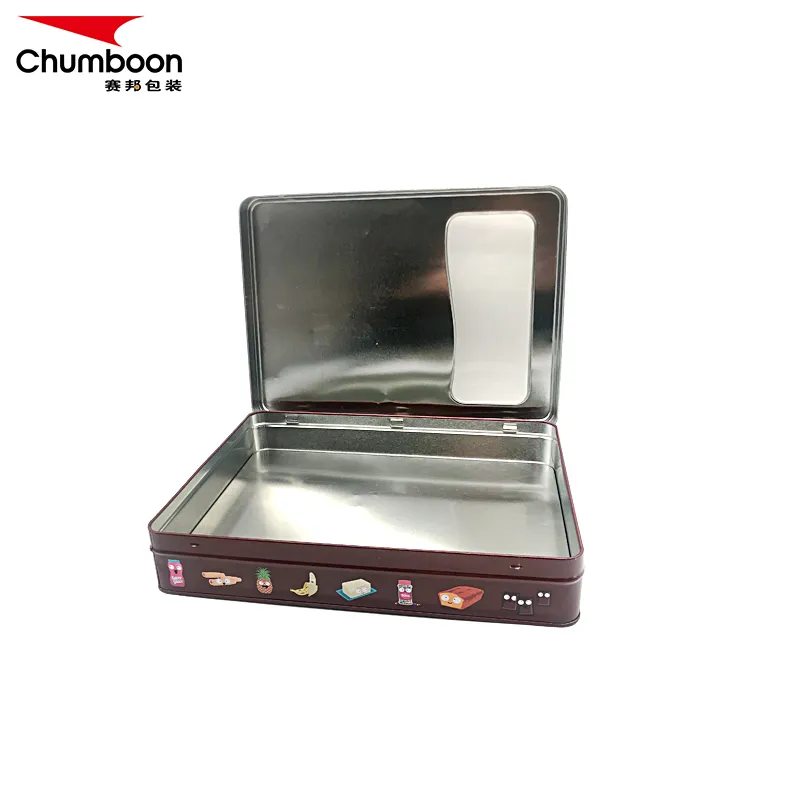In many families, cookie tin can is not only a container for storing snacks, but also a carrier of childhood memories. Those exquisite cookie tin cans, printed with various patterns, not only make people look forward to the deliciousness inside, but also become a unique decoration.
However, many people have a misunderstanding about the materials used to make cookie tin cans, thinking that they are made of 100% tin. So, is the material of cookie tin can really made of tin? This article will explore the materials and characteristics of cookie tin cans in detail to answer this common question.

What are the main materials used to make cookie tin cans?
In fact, most cookie tin cans are not made of pure tin, but of tinplate. Tinplate is a composite material with a layer of tin on the surface of an iron plate. The following is a detailed introduction to tinplate and other common cookie tin can materials.
Tinplate
Tinplate is one of the most common materials for cookie tin cans. Its manufacturing process includes coating the surface of the iron plate with a thin layer of tin. This composite material has both the anti-corrosion properties of tin and the strength and hardness of iron. The specific features are as follows:
● Strong anti-corrosion performance: The tin coating can effectively prevent the iron plate from contacting with oxygen and moisture in the air, preventing rust and corrosion.
● Good sealing: The tin-plated iron cookie tin can has excellent sealing performance through a strict crimping process or welding process, which can effectively isolate air and moisture and keep the biscuits fresh.
● High mechanical strength: Tin-plated iron has high mechanical strength and can withstand external pressure and impact to protect the biscuits from damage.
● Exquisite appearance: The surface of tin-plated iron is easy to print and paint, and can be decorated in a variety of ways to enhance the beauty of the cookie tin can.
Plastic
Plastic cookie tin can is also a common packaging form, especially in the modern packaging industry. Commonly used plastic materials include PET, PP, PE, etc. Plastic cookie tin can has the following characteristics:
● Light weight: Plastic cookie tin can is lighter than other materials and is easy to carry and transport.
● Low cost: Plastic materials have low cost and simple manufacturing process, which is suitable for large-scale production.
● High transparency: Transparent plastic materials such as PET allow consumers to directly see the biscuits in the can, increasing their desire to buy.
● Strong durability: Plastic cookie tin can has strong drop resistance and durability, and is not easy to break.
Glass
Glass cookie tin can is a more high-end packaging form, often used for high-end biscuits. Glass cookie tin can has the following characteristics:
● Good chemical stability: Glass material has stable chemical properties and does not react with biscuits, ensuring food safety.
● Transparent and beautiful: Glass cookie tin can has high transparency, which can clearly show the color and shape of biscuits and enhance the attractiveness of the product.
● High-end texture: Glass cookie tin can has high-end texture and is suitable for gift biscuit packaging to increase the added value of the product.
● Fragile: Glass cookie tin can is relatively heavy and fragile, and needs to be carefully handled and stored.
Aluminum alloy
Aluminum alloy cookie tin can has gradually become popular in recent years, especially in environmentally friendly packaging. Aluminum alloy cookie tin can has the following characteristics:
● Good corrosion resistance: Aluminum alloy material has good corrosion resistance and is not easy to rust.
● Light weight: Aluminum alloy cookie tin can is lighter than glass jars and is easy to carry and transport.
● Strong recyclability: Aluminum alloy materials can be recycled repeatedly and meet environmental protection requirements.
● High mechanical strength: Aluminum alloy has high mechanical strength and can effectively protect cookies.
Paper material
Paper cookie tin can is an environmentally friendly packaging, often used for gift biscuit packaging. Paper cookie tin can has the following characteristics:
● Environmentally friendly and degradable: Paper materials are degradable and will not pollute the environment.
● Light weight: Paper cookie tin can is light and easy to carry and transport.
● Diverse designs: Paper cookie tin can can be printed and designed in a variety of ways to enhance the beauty of the product.
● Poor moisture resistance: Paper materials have poor moisture resistance and usually require a moisture-proof lining.

What is the production process of tinned iron?
The production process of tin-plated iron mainly includes the following steps:
Iron plate preparation
First, the iron plate (usually low carbon steel) required for the production of tin-plated iron needs to be pickled, cold rolled and other treatments to ensure that its surface is smooth and flat and the thickness is uniform. These iron plates are usually called black iron plates.
Electroplating tin
During the electroplating process, the black iron plate is immersed in an electrolyte containing tin ions, and the tin ions are reduced and deposited on the surface of the iron plate by electric current. The electroplating process requires precise control of current, voltage and time to ensure that the tin layer is uniform and dense. The iron plate after electroplating is called tin-plated iron.
Annealing treatment
The iron plate after electroplating tin needs to be annealed to eliminate stress during processing and improve the toughness and ductility of the material. The annealing process is usually carried out at high temperature and the cooling rate needs to be controlled to obtain ideal material properties.
Surface treatment
Finally, tin-plated iron needs to be surface treated to improve its corrosion resistance and aesthetics. Common surface treatment methods include painting, printing and glazing. These treatments not only enhance the durability of tin-plated iron, but also add visual appeal to the cookie tin can.
Comparison of the advantages and disadvantages of cookie tin cans of different materials
When choosing a cookie tin can, the advantages and disadvantages of different materials directly affect the storage and transportation of cookies. The following is a comparison of the advantages and disadvantages of cookie tin cans of several common materials:
Tin-plated iron cookie tin can
● Advantages: strong corrosion resistance, good sealing, high mechanical strength, and exquisite appearance.
● Disadvantages: heavy weight and high cost.
Plastic cookie tin can
● Advantages: light weight, low cost, high transparency, and strong durability.
● Disadvantages: poor heat resistance and may have a plastic taste.
Glass cookie tin can
● Advantages: good chemical stability, transparent and beautiful, high-end texture.
● Disadvantages: heavy weight and easy to break.
Aluminum alloy cookie tin can
● Advantages: good corrosion resistance, light weight, strong recyclability, and high mechanical strength.
● Disadvantages: high cost and may have a metallic taste.
Paper cookie tin can
● Advantages: environmentally friendly and degradable, light weight, and various designs.
● Disadvantages: poor moisture resistance and low mechanical strength.

The impact of cookie tin can materials on cookie quality
The impact of cookie tin cans made of different materials on cookie quality is mainly reflected in the following aspects:
Moisture resistance
Biscuits easily absorb moisture, causing them to become soft and lose their crispness, affecting the taste. Tin-plated iron, plastic, glass and aluminum alloy cookie tin cans all have good moisture resistance and can effectively isolate moisture. However, paper cookie tin cans have poor moisture resistance and usually require a moisture-proof lining.
Anti-oxidation performance
Biscuits are easily oxidized when exposed to air for a long time, resulting in a poor taste. Tin-plated iron, glass and aluminum alloy cookie tin cans have good sealing performance, which can effectively isolate air and prevent biscuits from oxidation. The sealing performance of plastic cookie tin cans is slightly inferior, but it can also play a certain anti-oxidation role.
Physical protection
Biscuits are easily compressed and collided during transportation and storage, causing them to break or deform. Tinplate, glass and aluminum alloy cookie tin cans have high mechanical strength and can provide good physical protection. Plastic cookie tin cans are shatterproof but have slightly inferior mechanical strength. Paper cookie tin cans have low mechanical strength and limited physical protection.
In summary, cookie tin cans are not made of 100% tin, but of tinplate. Tinplate combines the anti-corrosion properties of tin and the mechanical strength of iron by coating a layer of tin on the surface of the iron plate, making it an ideal cookie tin can material. In addition to tinplate, plastic, glass, aluminum alloy and paper materials are also common cookie tin can production materials, each with its own advantages and disadvantages, suitable for different needs and application scenarios.

